Concerned or Apathetic? Using Social Media Platform (Twitter) to Gauge the Public Awareness about Wildlife Conservation: A Case Study of the Illegal Rhino Trade
Abstract
:1. Introduction
2. Literature Review
2.1. Traditional Research on Wildlife Conservation
2.2. Wildlife Conservation Based on Social Media
2.3. Rhino Protection
3. Data and Methods
3.1. Data
3.1.1. Background Data
3.1.2. Twitter and Users’ Profiles
3.2. Methods
3.2.1. Building up Rhino Trade Network
3.2.2. Information Extraction of Tweets Contents
3.2.3. Geolocation Resolving Algorithm
3.2.4. Influential Users’ Network
3.2.5. Topic Analysis through Word Cloud
3.2.6. Geographical Distribution of Sentiment
- Obtain a set of aggregated negative emotional indices , where denotes the aggregated negative emotional index of country , and denotes the set of countries that have aggregated negative emotional index.
- Obtain and denoting the set population and Individuals using the Internet of country , respectively, and then calculate , which represents the population of Internet users in country .
- Use the max–min method to normalize the set of aggregated negative emotional index and the set of the population of Internet users. Thus, obtain two normalized sets, marking them as and .
- Find out the adjusted aggregated negative emotional index computed as . (In case the denominator equals 0, add 0.01 to the denominator to make the fraction meaningful.)
- Again, use the max–min method to normalize the set of adjusted indices and obtain .
4. Empirical Results and Discussion
4.1. Overall Level of Global Rhino Trade
4.2. Effects of Online News on Tweeting
4.3. Influential Users’ Analysis
4.4. Content Analysis
4.4.1. Topics
4.4.2. Locations
4.4.3. Persons
4.5. Sentiment Analysis
5. Conclusions
Author Contributions
Funding
Institutional Review Board Statement
Informed Consent Statement
Data Availability Statement
Conflicts of Interest
References
- Traffic Info. Available online: https://www.traffic.org/about-us/legal-wildlife-trade/ (accessed on 25 July 2019).
- Challender, D.W.S.; Harrop, S.R.; MacMillan, D.C. Towards Informed and Multi-Faceted Wildlife Trade Interventions. Glob. Ecol. Conserv. 2015, 3, 129–148. [Google Scholar] [CrossRef] [Green Version]
- Hernandez-Castro, J.; Roberts, D.L. Automatic Detection of Potentially Illegal Online Sales of Elephant Ivory Via Data Mining. PeerJ Comput. Sci. 2015, 1, e10. [Google Scholar] [CrossRef] [Green Version]
- Karesh, W.B.; Cook, R.A.; Bennett, E.L.; Newcomb, J. Wildlife Trade and Global Disease Emergence. Emerg. Infect. Dis. 2005, 11, 1000–1002. [Google Scholar] [CrossRef] [PubMed]
- Di Minin, E.; Fink, C.; Tenkanen, H.; Hiippala, T. Machine Learning for Tracking Illegal Wildlife Trade on Social Media. Nat. Ecol. Evol. 2018, 2, 406–407. [Google Scholar] [CrossRef]
- Walley, J. Wildlife Crime: Third Report of Session 2012–2013; Report, Together with Formal Minutes, Oral and Written Evidence; Great Britain; Parliament; House of Commons; Environmental Audit Committee: London, UK, 2013; Volume 1. [Google Scholar]
- Hansen, A.L.S.; Li, A.; Joly, D.; Mekaru, S.; Brownstein, J.S. Digital Surveillance: A Novel Approach to Monitoring the Illegal Wildlife Trade. PLoS ONE 2012, 7, e51156. [Google Scholar]
- Wu, Y.; Xie, L.; Huang, S.-L.; Li, P.; Yuan, Z.; Liu, W. Using Social Media to Strengthen Public Awareness of Wildlife Conservation. Ocean Coast. Manag. 2018, 153, 76–83. [Google Scholar] [CrossRef]
- Gao, Y.; Stoner, K.J.; Lee, A.T.L.; Clark, S.G. Rhino Horn Trade in China: An Analysis of the Art and Antiques Market. Biol. Conserv. 2016, 201, 343–347. [Google Scholar] [CrossRef]
- Rhino Horn as Medicine. Available online: https://www.rhinosinfo.com/rhino-horn-as-medicine.html (accessed on 25 July 2019).
- Rhino Info. Available online: https://www.savetherhino.org/rhino-info/ (accessed on 25 July 2019).
- Rosen, G.E.; Smith, K.F. Summarizing the Evidence on the International Trade in Illegal Wildlife. Ecohealth 2010, 7, 24–32. [Google Scholar] [CrossRef]
- CITES. Available online: https://trade.cites.org (accessed on 25 July 2019).
- Roberge, J.M. Using Data from Online Social Networks in Conservation Science: Which Species Engage People the Most on Twitter? Biodivers. Conserv. 2014, 23, 715–726. [Google Scholar] [CrossRef]
- Kankanamge, N.; Yigitcanlar, T.; Goonetilleke, A.; Kamruzzaman, M. Determining Disaster Severity through Social Media Analysis: Testing the Methodology with South East Queensland Flood Tweets. Int. J. Disaster Risk Reduct. 2020, 42, 101360. [Google Scholar] [CrossRef]
- Financial Information. Available online: https://investor.twitterinc.com/financial-information/default.aspx (accessed on 25 July 2019).
- Alnazzawi, N. Using Twitter to Detect Hate Crimes and Their Motivations: The HateMotiv Corpus. Data 2022, 7, 69. [Google Scholar] [CrossRef]
- Boas, I. The diversification of pastoralist herding: Navigating socio-climatic risk via mobile technologies. J. Ethn. Migr. Stud. 2022, 1–17. [Google Scholar] [CrossRef]
- Hu, Q.; An, S.; Kapucu, N.; Sellnow, T.; Yuksel, M.; Freihaut, R. Dynamics of Interorganizational Emergency Communication on Twitter: The Case of Hurricane Irma. Disasters, 2022; Epub ahead of print. [Google Scholar] [CrossRef]
- Shan, S.; Zhao, F.; Wei, Y.; Liu, M. Disaster management 2.0: A real-time disaster damage assessment model based on mobile social media data—A case study of Weibo (Chinese Twitter). Saf. Sci. 2019, 115, 393–413. [Google Scholar] [CrossRef]
- Kidd, L.R.; Gregg, E.A.; Bekessy, S.A.; Robinson, J.A.; Garrard, G.E. Tweeting for Their Lives: Visibility of Threatened Species on Twitter. J. Nat. Conserv. 2018, 46, 106–109. [Google Scholar] [CrossRef]
- McCombs, M.E.; Shaw, D.L. The Agenda-setting Function of Mass Media. Public Opin. Q. 1972, 36, 176–187. [Google Scholar] [CrossRef]
- Ribeiro, J.; Reino, L.; Schindler, S.; Strubbe, D.; Vall-Ilosera, M.; Araujo, M.B.; Capinha, C.; Carrete, M.; Mazzoni, S.; Monteiro, M.; et al. Trends in Legal and Illegal Trade of Wild Birds: A Global Assessment Based on Expert Knowledge. Biodivers. Conserv. 2019, 28, 3343–3369. [Google Scholar] [CrossRef]
- Verissimo, D.; Wan, A.K.Y. Characterizing Efforts to Reduce Consumer Demand for Wildlife Products. Conserv. Biol. 2019, 33, 623–633. [Google Scholar] [CrossRef]
- Daut, E.F.; Brightsmith, D.J.; Peterson, M.J. Role of non-governmental organizations in combating illegal wildlife–pet trade in Peru. J. Nat. Conserv. 2015, 24, 72–82. [Google Scholar] [CrossRef]
- Nijman, V. Wildlife Trade, Cites and the Protection of Marine Molluscs in Indonesia. Molluscan Res. 2019, 39, 195–204. [Google Scholar] [CrossRef]
- Harfoot, M.; Glaser, S.A.M.; Tittensor, D.P.; Britten, G.L.; McLardy, C.; Malsch, K.; Burgess, N.D. Unveiling the Patterns and Trends in 40 Years of Global Trade in Cites-Listed Wildlife. Biol. Conserv. 2018, 223, 47–57. [Google Scholar] [CrossRef]
- Symes, W.S.; McGrath, F.L.; Rao, M.; Carrasco, L.R. The Gravity of Wildlife Trade. Biol. Conserv. 2018, 218, 268–276. [Google Scholar] [CrossRef]
- Berec, M.; Vršecká, L.; Šetlíková, I. What Is the Reality of Wildlife Trade Volume? Cites Trade Database Limitations. Biol. Conserv. 2018, 224, 111–116. [Google Scholar] [CrossRef]
- Paudel, K.; Hinsley, A.; Veríssimo, D.; Milner-Gulland, E. Evaluating the reliability of media reports for gathering information about illegal wildlife trade seizures. PeerJ 2022, 10, e13156. [Google Scholar] [CrossRef] [PubMed]
- Di Minin, E.; Tenkanen, H.; Toivonen, T. Prospects and Challenges for Social Media Data in Conservation Science. Front. Environ. Sci. 2015, 3, 63. [Google Scholar] [CrossRef] [Green Version]
- Toivonen, T.; Heikinheimo, V.; Fink, C.; Hausmann, A.; Hiippala, T.; Järv, O.; Tenkanen, H.; Di Minin, E. Social Media Data for Conservation Science: A Methodological Overview. Biol. Conserv. 2019, 233, 298–315. [Google Scholar] [CrossRef]
- Di Minin, E.; Fink, C.; Hiippala, T.; Tenkanen, H. A Framework for Investigating Illegal Wildlife Trade on Social Media with Machine Learning. Conserv. Biol. 2019, 33, 210–213. [Google Scholar] [CrossRef] [PubMed] [Green Version]
- Siriwat, P.; Nijman, V. Illegal Pet Trade on Social Media as an Emerging Impediment to the Conservation of Asian Otters Species. J. Asia-Pac. Biodivers. 2018, 11, 469–475. [Google Scholar] [CrossRef]
- Martin, R.O.; Senni, C.; D’Cruze, N.C. Trade in Wild-Sourced African Grey Parrots: Insights via Social Media. Glob. Ecol. Conserv. 2018, 15, e00429. [Google Scholar] [CrossRef]
- Nghiem, L.T.P.; Webb, E.L.; Carrasco, L.R. Saving Vietnam’s Wildlife through Social Media. Science 2012, 338, 192–193. [Google Scholar] [CrossRef]
- Patel, N.G.; Rorres, C.; Joly, D.O.; Brownstein, J.S.; Boston, R.; Levy, M.Z.; Smith, G. Quantitative Methods of Identifying the Key Nodes in the Illegal Wildlife Trade Network. Proc. Natl. Acad. Sci. USA 2015, 112, 7948–7953. [Google Scholar] [CrossRef] [Green Version]
- Margalida, A.; Haas, T.C.; Ferreira, S.M. Combating Rhino Horn Trafficking: The Need to Disrupt Criminal Networks. PLoS ONE 2016, 11, e0167040. [Google Scholar]
- Vu, H.N.D.; Nielsen, M.R.; Jacobsen, J.B. Conserving rhinos by legal trade: Insights from a choice experiment with rhino horn consumers. Ecol. Econ. 2022, 193, 107287. [Google Scholar]
- Ayling, J. What Sustains Wildlife Crime? Rhino Horn Trading and the Resilience of Criminal Networks. J. Int. Wildl. Law Policy 2013, 16, 57–80. [Google Scholar] [CrossRef]
- Hubschle, A.M. The Social Economy of Rhino Poaching: Of Economic Freedom Fighters, Professional Hunters and Marginalized Local People. Curr. Sociol. 2017, 65, 427–447. [Google Scholar] [CrossRef]
- Crookes, D.J.; Blignaut, J.N. Debunking the Myth That a Legal Trade Will Solve the Rhino Horn Crisis: A System Dynamics Model for Market Demand. J. Nat. Conserv. 2015, 28, 11–18. [Google Scholar] [CrossRef] [Green Version]
- Crookes, D.J. Does a Reduction in the Price of Rhino Horn Prevent Poaching? J. Nat. Conserv. 2017, 39, 73–82. [Google Scholar] [CrossRef]
- TweetScraper, version 1.0. Available online: https://github.com/jonbakerfish/TweetScraper (accessed on 25 July 2019).
- Ragini, J.R.; Anand, P.M.R.; Bhaskar, V. Big Data Analytics for Disaster Response and Recovery through Sentiment Analysis. Int. J. Inf. Manag. 2018, 42, 13–24. [Google Scholar] [CrossRef]
- Trade Monitoring. Available online: https://www.traffic.org/what-we-do/projects-and-approaches/trade-monitoring/ (accessed on 25 July 2019).
- Wang, K.; Meng, W.Y.; Li, S.J.; Yang, S. Multi-Modal Mention Topic Model for Mentionee Recommendation. Neurocomputing 2019, 325, 190–199. [Google Scholar] [CrossRef]
- Marrero, M.; Urbano, J.; Sánchez-Cuadrado, S.; Morato, J.; Gómez-Berbís, J.M. Named Entity Recognition: Fallacies, Challenges and Opportunities. Comput. Stand. Interfaces 2013, 35, 482–489. [Google Scholar] [CrossRef]
- Tweet Location. Available online: https://help.twitter.com/en/using-twitter/tweet-location (accessed on 25 July 2019).
- Graham, M.; Hale, S.A.; Gaffney, D. Where in the World Are You? Geolocation and Language Identification in Twitter. Prof. Geogr. 2014, 66, 568–578. [Google Scholar] [CrossRef] [Green Version]
- Kirilenko, A.P.; Molodtsova, T.; Stepchenkova, S.O. People as Sensors: Mass Media and Local Temperature Influence Climate Change Discussion on Twitter. Glob. Environ. Chang.-Hum. Policy Dimens. 2015, 30, 92–100. [Google Scholar] [CrossRef]
- Shan, S.; Ju, X.; Wei, Y.; Wang, Z. Effects of PM2.5 on People’s Emotion: A Case Study of Weibo (Chinese Twitter) in Beijing. Int. J. Environ. Res. Public Health 2021, 18, 5422. [Google Scholar] [CrossRef] [PubMed]
- Nielsen, F.A. A new ANEW: Evaluation of a word list for sentiment analysis in microblogs. In Proceedings of the ESWC 2011 Workshop on Making Sense of Microposts, Heraklion, Greece, 29–30 May 2011. [Google Scholar]
- Kirilenko, A.P.; Stepchenkova, S.O. Public Microblogging on Climate Change: One Year of Twitter Worldwide. Glob. Environ. Chang.-Hum. Policy Dimens. 2014, 26, 171–182. [Google Scholar] [CrossRef]
- Cha, M.; Haddadi, H.; Benevenuto, F.; Gummadi, K.P. Measuring User Influence in Twitter: The Million Follower Fallacy. In Proceedings of the Fourth International AAAI Conference on Weblogs and Social Media, Washington, DC, USA, 23–26 May 2010. [Google Scholar]
- Mission of NRDC. Available online: https://www.nrdc.org/about#mission (accessed on 25 July 2019).
- Witter, R.; Satterfield, T. Rhino Poaching and the “Slow Violence” of Conservation-Related Resettlement in Mozambique’s Limpopo National Park. Geoforum 2019, 101, 275–284. [Google Scholar] [CrossRef]
- Save the Rhino. Available online: https://www.savetherhino.org/programmes/borana-conservancy/ (accessed on 25 July 2019).
- CITES Management Authority. Rationale for Swaziland’s Proposal to CITES to Legalize Trade in Its Rhino Horn; Information Document for Amendment Proposal CoP17 Prop. 7 (CoP17 Inf. 17); The Kingdom of Swaziland’s Big Games Parks; CITES Management Authority: Geneva, Switzerland, 2016. [Google Scholar]
- Milliken, T. Illegal Trade in Ivory and Rhino Horn: An Assessment Report to Improve Law Enforcement Under the Wildlife; TRAFFIC: Cambridge, UK, 2014. [Google Scholar]
- News about Jackie Chan. Available online: https://www.awf.org/news/jackie-chan-stars-newest-anti-rhino-horn-vide (accessed on 25 July 2019).
- Defending Kenyas Rhinos. Available online: https://www.wwf.org.uk/what-we-do/projects/defending-kenyas-rhinos (accessed on 25 July 2019).
- Di Minin, E.; Laitila, J.; Montesino-Pouzols, F.; Leader-Williams, N.; Slotow, R.; Goodman, P.S.; Conway, A.J.; Moilanen, A. Identification of Policies for a Sustainable Legal Trade in Rhinoceros Horn Based on Population Projection and Socioeconomic Models. Conserv. Biol. 2015, 29, 545–555. [Google Scholar] [CrossRef] [PubMed]
- Liu, J.C.-E.; Zhao, B.J. Who Speaks for Climate Change in China? Evidence from Weibo. Clim. Chang. 2017, 140, 413–422. [Google Scholar] [CrossRef]
- Brulle, R.J.; Carmichael, J.; Jenkins, J.C. Shifting Public Opinion on Climate Change: An Empirical Assessment of Factors Influencing Concern over Climate Change in the Us, 2002–2010. Clim. Chang. 2012, 114, 169–188. [Google Scholar] [CrossRef]
- Hindman, M. The Myth of Digital Democracy; Princeton University Press: Princeton, NJ, USA, 2008. [Google Scholar]
- Gitlin, T. Media sociology: The dominant paradigm. Theory Soc. 1978, 6, 205–253. [Google Scholar] [CrossRef]
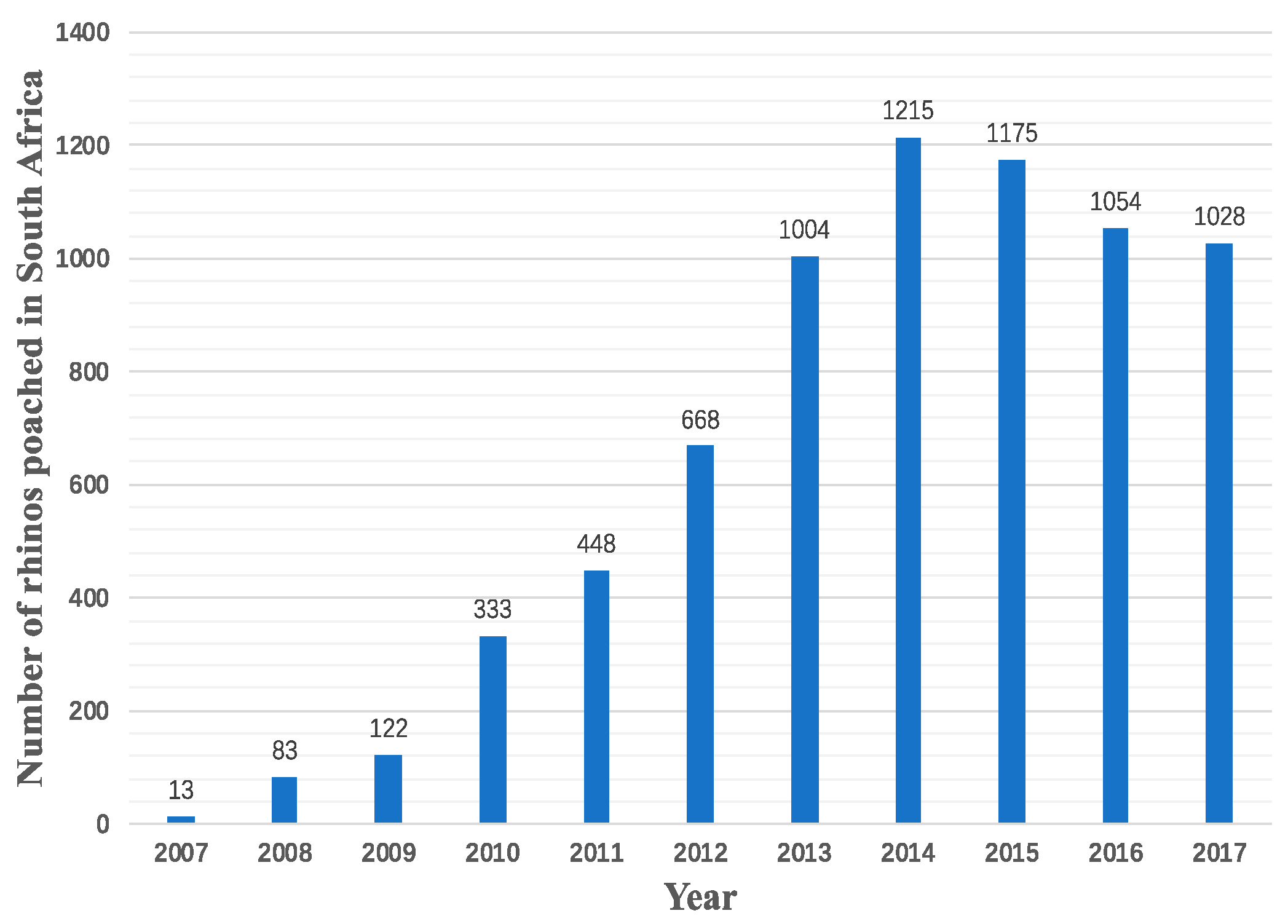
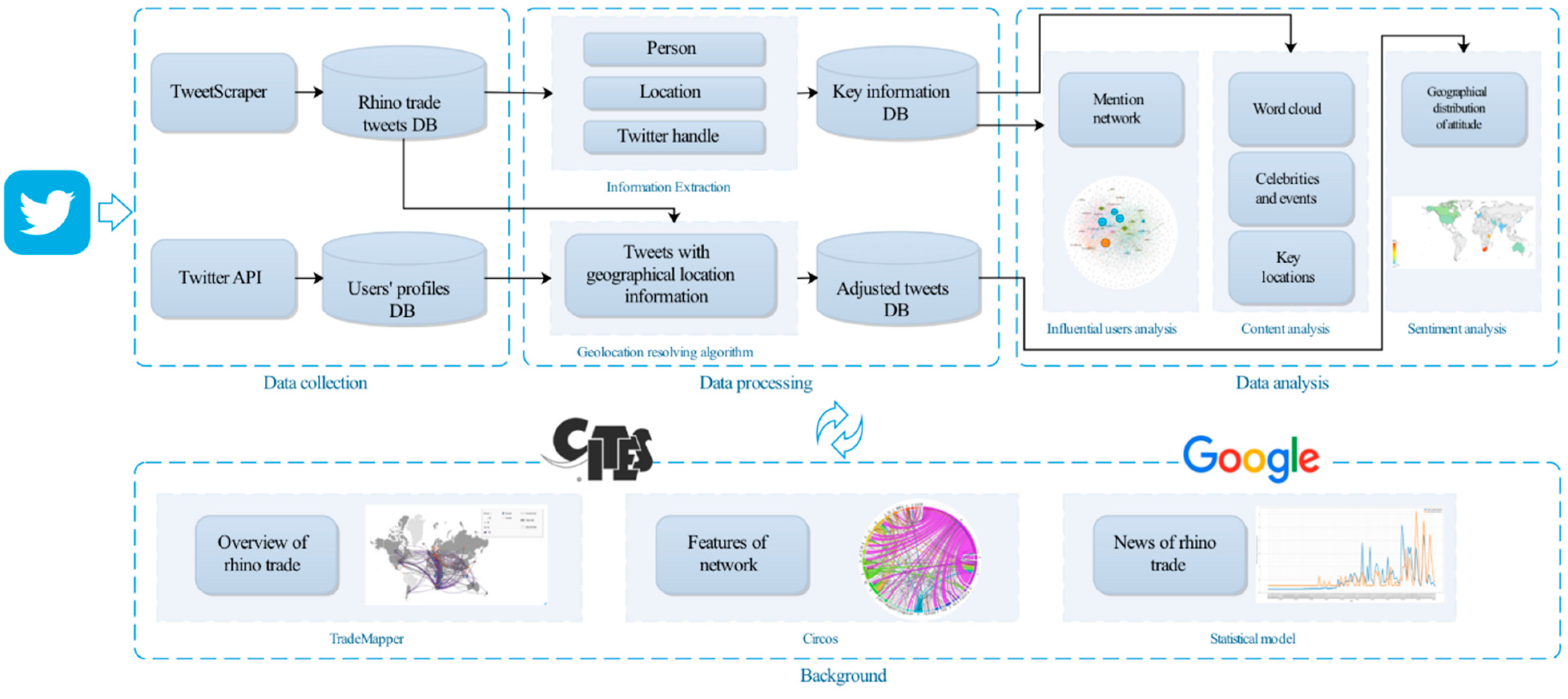
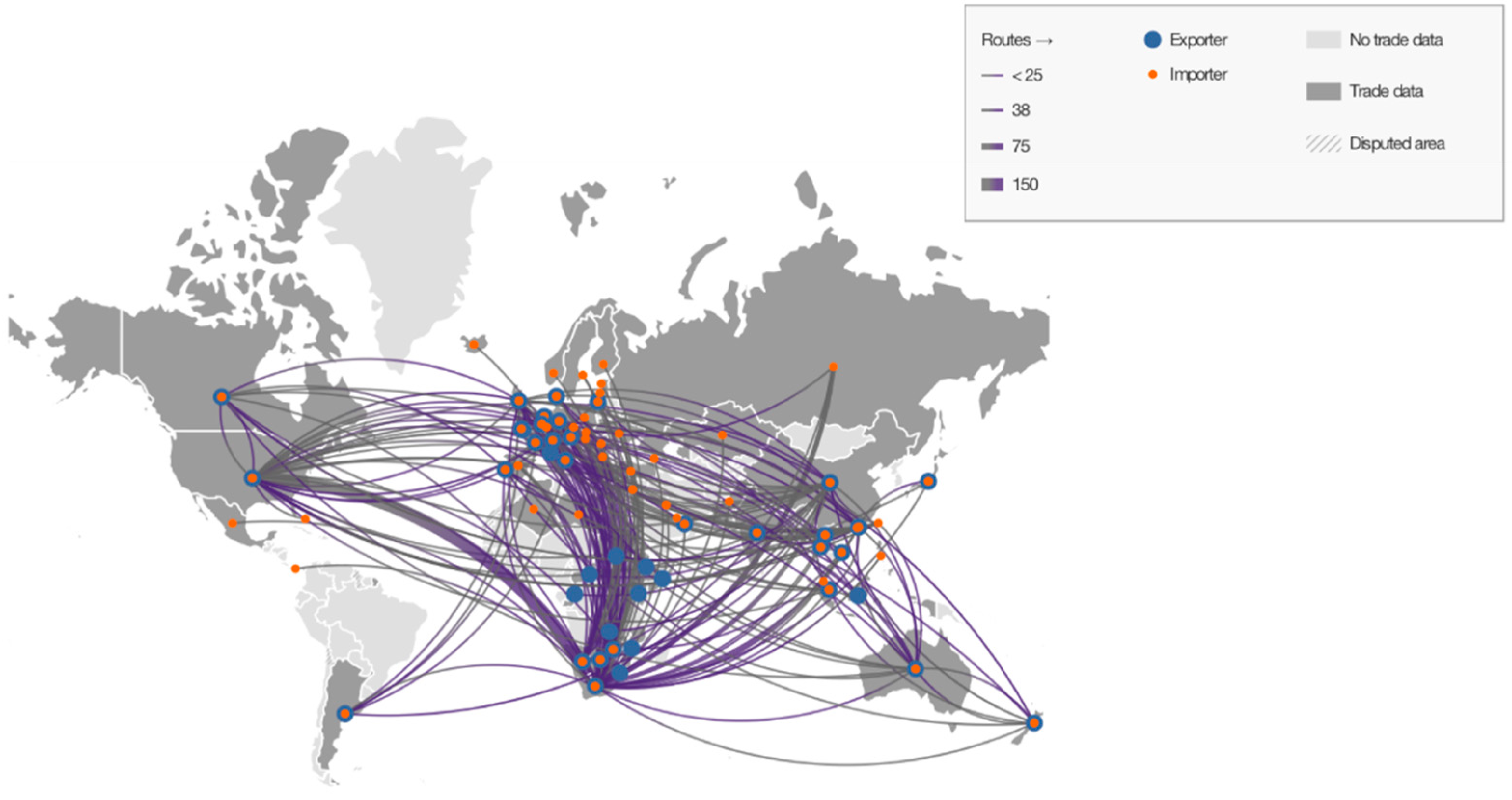
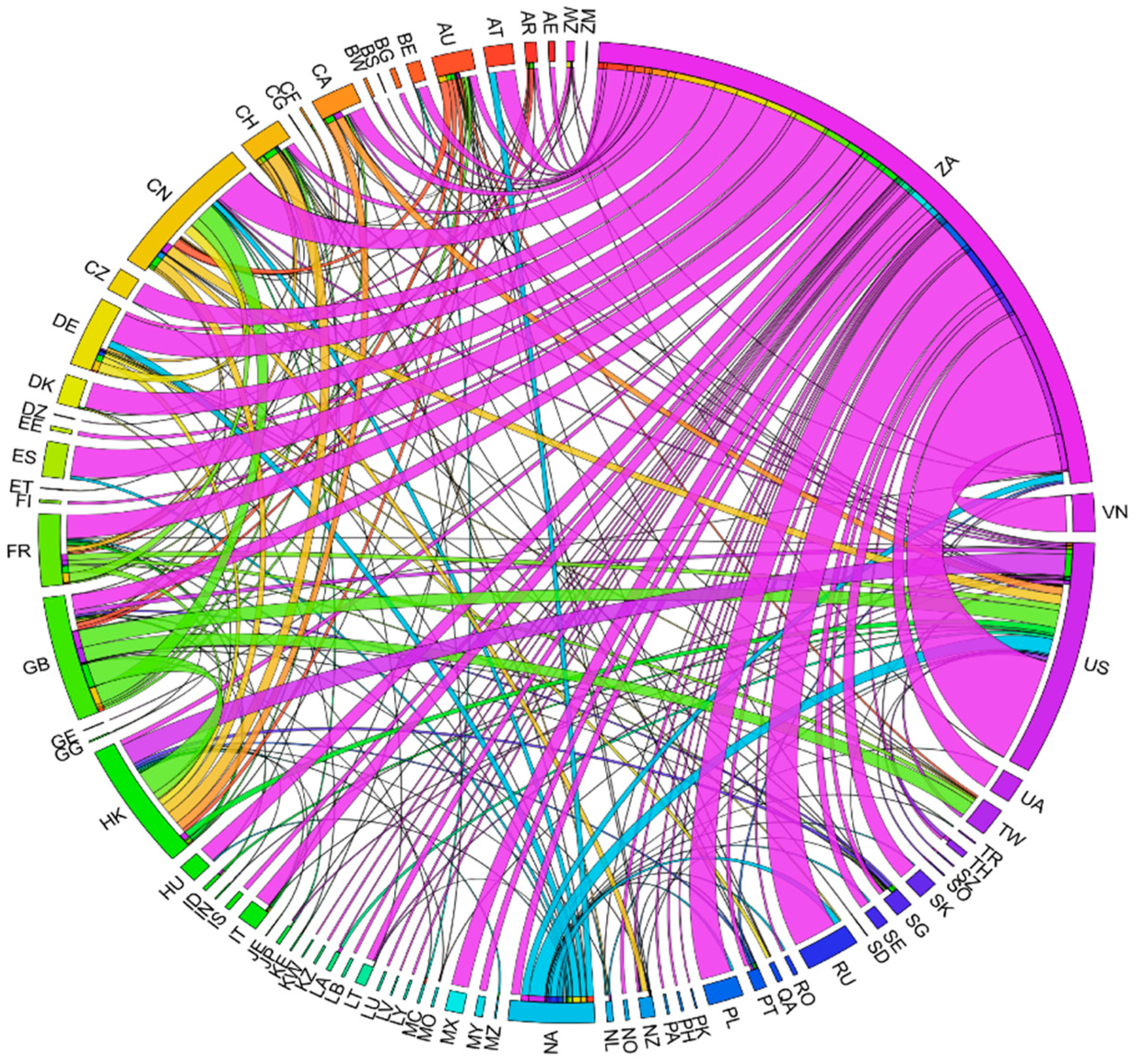


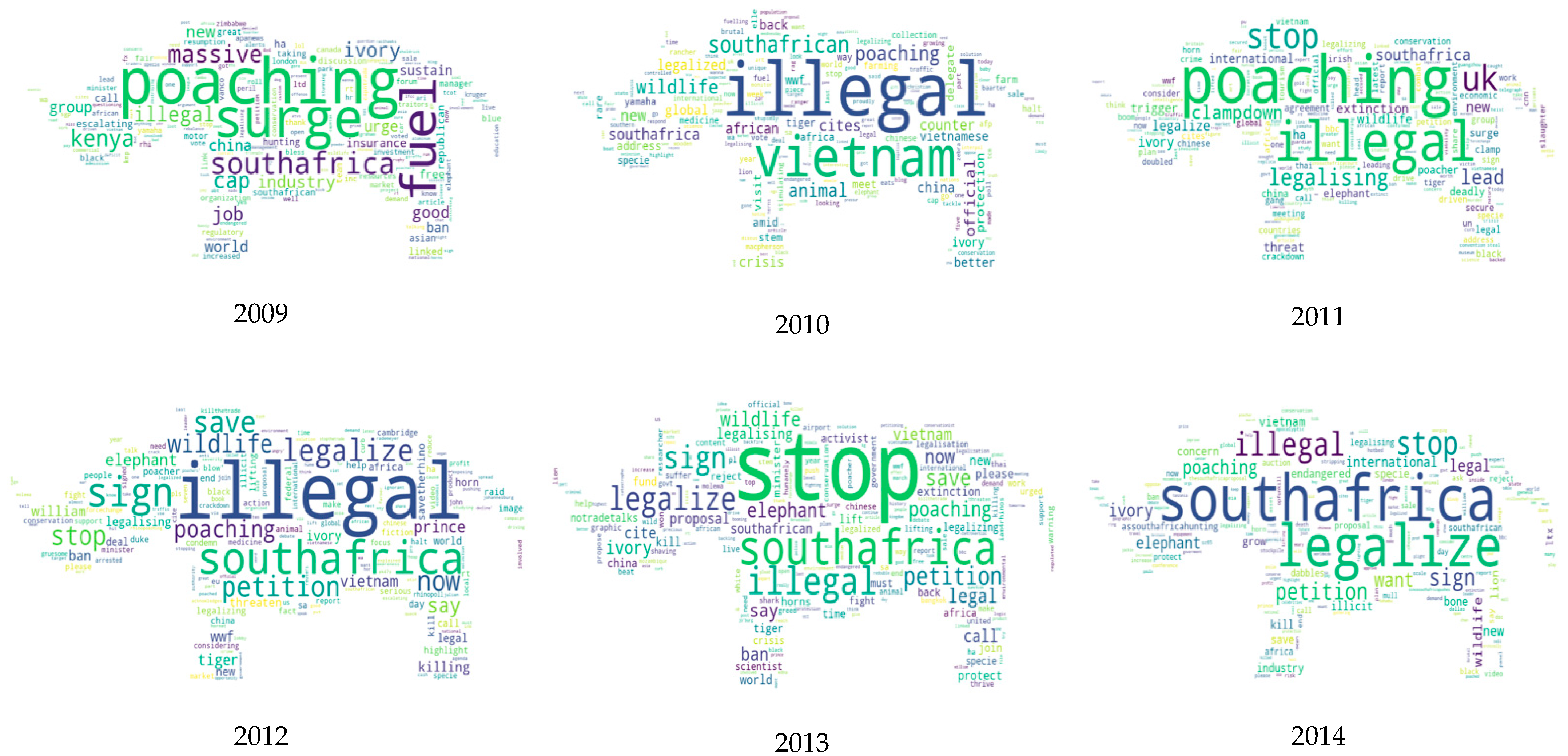

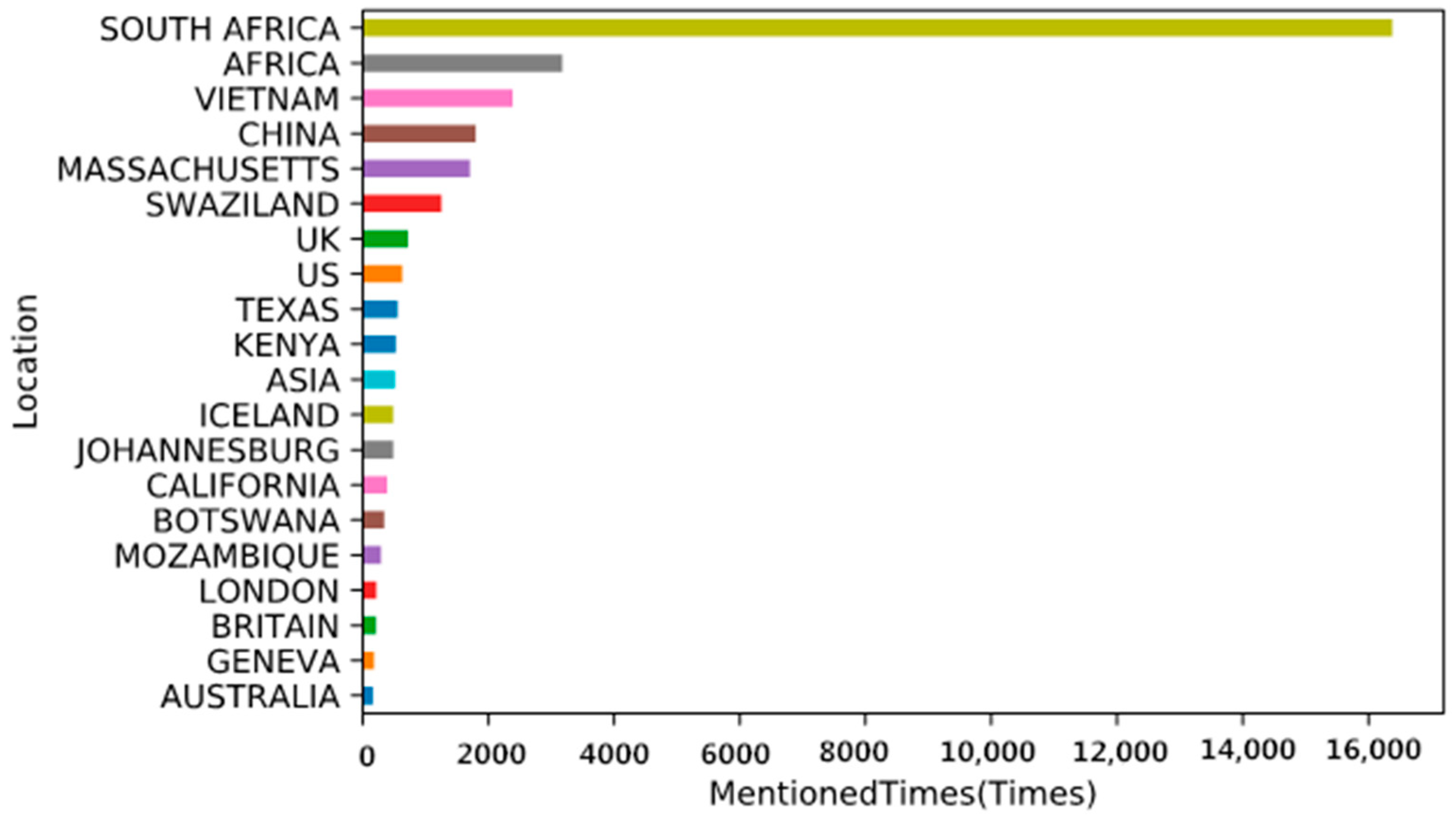
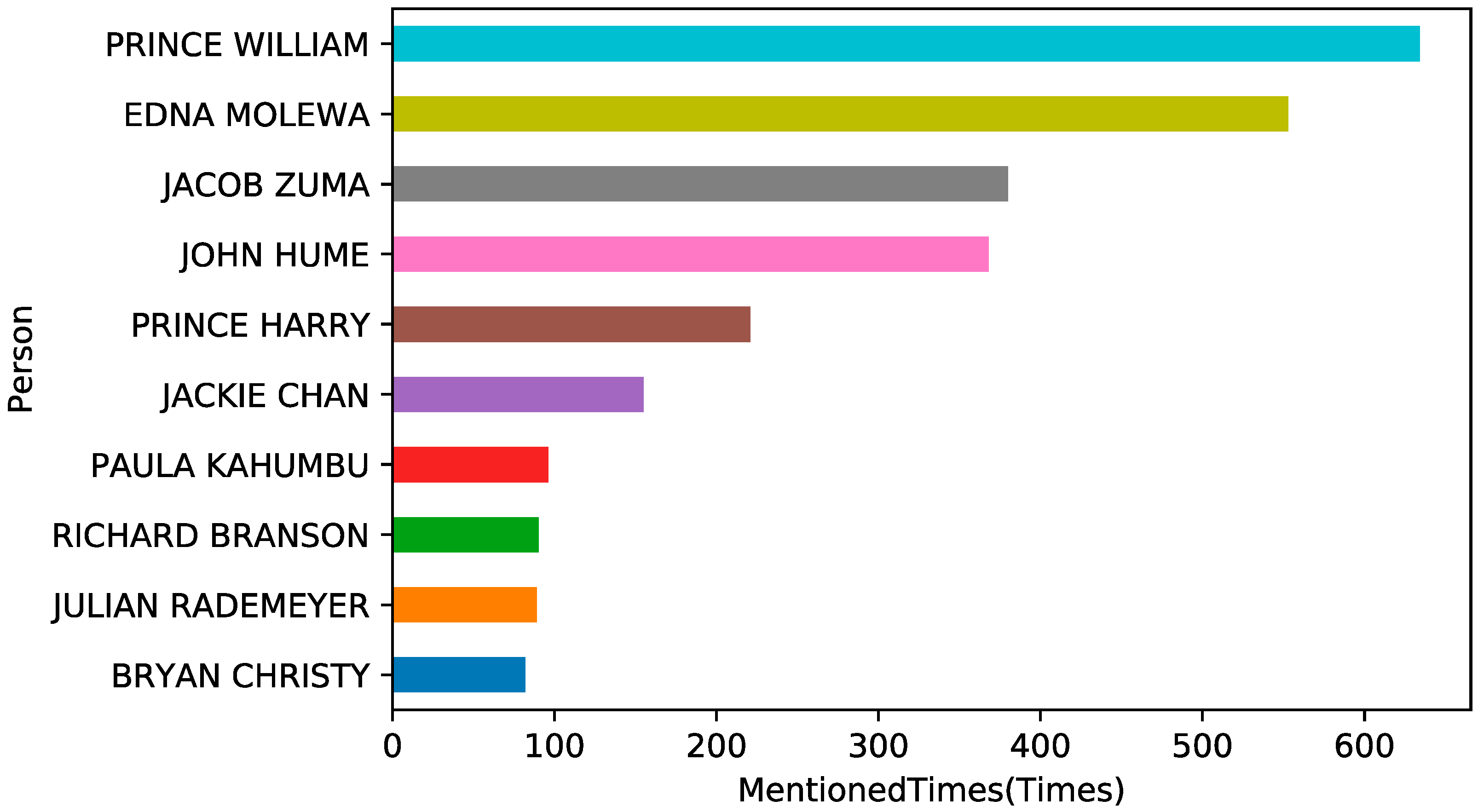
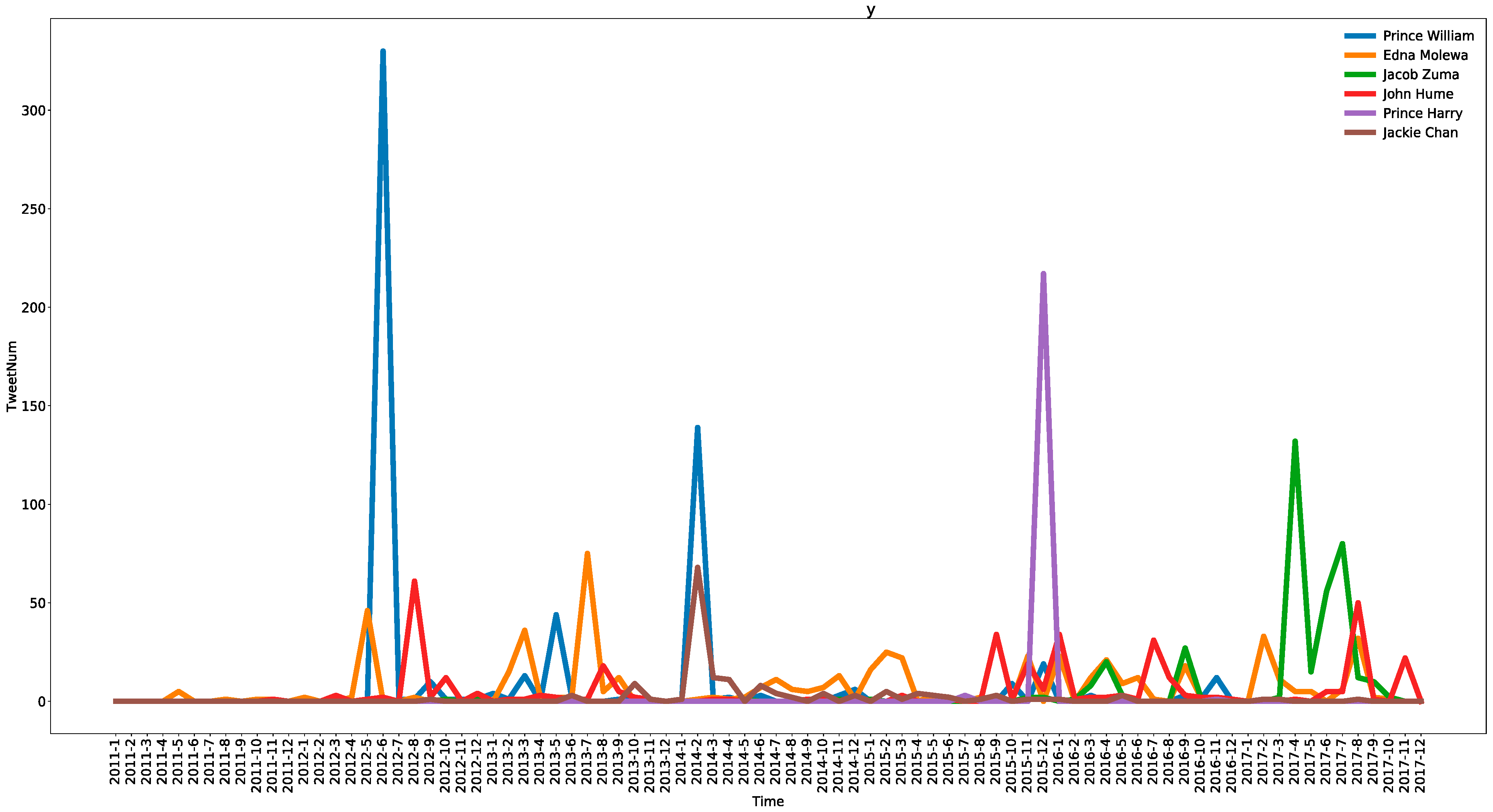

| Origination | Number of Cases |
|---|---|
| ZA | 857 |
| NA | 94 |
| ZW | 5 |
| PT | 3 |
| AU | 2 |
| SZ | 2 |
| BW | 1 |
| DE | 1 |
| US | 1 |
| ID | 1 |
| IT | 1 |
| LT | 1 |
| ZM | 1 |
| Destination | Number of Case |
|---|---|
| US | 125 |
| CN | 54 |
| RU | 54 |
| VN | 50 |
| ES | 44 |
| PL | 42 |
| DE | 42 |
| DK | 37 |
| UA | 33 |
| CZ | 29 |
| FR | 29 |
| User Id | Outdegree | User Type |
|---|---|---|
| Change | 1703 | Private Company |
| Avaaz | 1577 | NGO |
| NRDC | 1486 | NGO |
| HSIGlobal | 1196 | NGO |
| NatGeo | 704 | Media |
| TakePart | 633 | Media |
| CITES | 465 | GO |
| WWF | 439 | NGO |
| USFWS | 314 | GO |
| EleRhinoMarch | 273 | Private Company |
| environmentza | 273 | GO |
| USFWSIntl | 239 | GO |
| guardian | 221 | Media |
| causes | 200 | Private Company |
| UKChange | 180 | Private Company |
| savetherhino | 176 | NGO |
| AWF_Official | 175 | NGO |
| ForceChange | 155 | Private Company |
| africageo | 152 | Media |
| sharethis | 147 | Media |
| CITESconvention | 134 | GO |
| NPR | 131 | Media |
| po_st | 127 | Media |
| USFWSHQ | 126 | GO |
| WildAid | 122 | NGO |
| c0nvey | 120 | Media |
| News24 | 116 | Media |
| User Type | Total Outdegree | User Number | Average Outdegree per User |
|---|---|---|---|
| Media | 2351 | 9 | 261 |
| NGO | 5171 | 7 | 739 |
| GO | 1551 | 6 | 259 |
| Private Company | 2511 | 5 | 502 |
| Year | Top 5 Negative Emotional Index | ||||
|---|---|---|---|---|---|
| 2009 | ZA | KE | GB | BE | CA |
| 2010 | ZA | SG | GB | FJ | ZW |
| 2011 | ZA | IE | KE | GB | US |
| 2012 | ZA | GB | KE | AU | CA |
| 2013 | GB | ZA | NZ | IE | AU |
| 2014 | ZA | GB | KE | AU | CA |
| 2015 | ZA | GB | KE | US | CA |
| 2016 | ZA | GB | KE | US | CA |
| 2017 | GB | ZA | US | AU | KE |
Publisher’s Note: MDPI stays neutral with regard to jurisdictional claims in published maps and institutional affiliations. |
© 2022 by the authors. Licensee MDPI, Basel, Switzerland. This article is an open access article distributed under the terms and conditions of the Creative Commons Attribution (CC BY) license (https://creativecommons.org/licenses/by/4.0/).
Share and Cite
Shan, S.; Ju, X.; Wei, Y.; Wen, X. Concerned or Apathetic? Using Social Media Platform (Twitter) to Gauge the Public Awareness about Wildlife Conservation: A Case Study of the Illegal Rhino Trade. Int. J. Environ. Res. Public Health 2022, 19, 6869. https://doi.org/10.3390/ijerph19116869
Shan S, Ju X, Wei Y, Wen X. Concerned or Apathetic? Using Social Media Platform (Twitter) to Gauge the Public Awareness about Wildlife Conservation: A Case Study of the Illegal Rhino Trade. International Journal of Environmental Research and Public Health. 2022; 19(11):6869. https://doi.org/10.3390/ijerph19116869
Chicago/Turabian StyleShan, Siqing, Xijie Ju, Yigang Wei, and Xin Wen. 2022. "Concerned or Apathetic? Using Social Media Platform (Twitter) to Gauge the Public Awareness about Wildlife Conservation: A Case Study of the Illegal Rhino Trade" International Journal of Environmental Research and Public Health 19, no. 11: 6869. https://doi.org/10.3390/ijerph19116869
APA StyleShan, S., Ju, X., Wei, Y., & Wen, X. (2022). Concerned or Apathetic? Using Social Media Platform (Twitter) to Gauge the Public Awareness about Wildlife Conservation: A Case Study of the Illegal Rhino Trade. International Journal of Environmental Research and Public Health, 19(11), 6869. https://doi.org/10.3390/ijerph19116869







